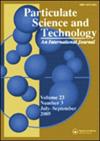利用体积特性预测粉煤灰的气力输送性和流动性
IF 1.5
4区 工程技术
Q3 ENGINEERING, CHEMICAL
引用次数: 0
摘要
摘要火力发电厂的气力飞灰输送系统由于灰特性的变化和/或系统尺寸的不足导致发电损失和灰利用率的降低,往往不能按预期的职责输送灰。本文是对灰的物理特性与一些重要的设计准则(如灰的可输送性和流动性)之间的关系进行研究的结果。基于一个综合的测试程序,包括气力输送(在一个中试工厂)和从五个不同电厂获得的23个灰样的流动特性测试,使用散装特性表征对可输送性和流动性进行了预测。在研究的所有颗粒和体参数中,休止角是连接可输送性和流动性的最重要参数。一种基于休止角的新开发设计工具有望帮助设计人员和操作工程师预测流动状况,并根据合适的操作参数选择合适的设备/系统尺寸。关键词:粉煤灰;气力输送;流动能力;“NTPC赞助的研究学者Gouarv Saluja感谢NTPC为他提供奖学金”。作者要感谢塔帕尔工程技术研究所(TIET)和Granutools(比利时)在GranuHeap仪器的使用上的合作。披露声明作者未报告潜在的利益冲突。本文章由计算机程序翻译,如有差异,请以英文原文为准。
Predicting pneumatic conveyability and flowability of fly ash using bulk property characterization
AbstractPneumatic fly ash conveying systems in thermal power plants are often not able to transport ash as per their expected duty due to either variability of ash characteristics and/or inadequate system sizing resulting in generation loss and reduced ash utilization. This paper results from an ongoing investigation into the relationship between the physical characteristics of ash to some of the important design criteria, such as ash conveyability and flowability. Based on a comprehensive test program including the pneumatic conveying (in a pilot plant) and flow property testing of 23 ash samples obtained from five different power stations, predictions for conveyability and flowability have been made using bulk property characterization. Of all the different particle and bulk parameters investigated, the angle of repose has been found to be the most significant parameter linking conveyability and flowability. A newly developed design tool based on the angle of repose is expected to assist designers and operational engineers to predict the flow condition and appropriately size equipment/system with suitable operating parameters.Keywords: Fly ashpneumatic conveyingflowabilityhausner ratioangle of repose AcknowledgementThe authors would like to thank NTPC Ltd., India for the sponsored research project – sanction letter ref. 9100000168-151-1001. “NTPC sponsored Research Scholar, Gouarv Saluja, would like to thank NTPC for providing him scholarship”.The authors would like to acknowledge the collaboration between Thapar Institute of Engineering & Technology (TIET) and Granutools (Belgium) for the use of the GranuHeap instrument.Disclosure statementNo potential conflict of interest was reported by the author(s).
求助全文
通过发布文献求助,成功后即可免费获取论文全文。
去求助
来源期刊

Particulate Science and Technology
工程技术-工程:化工
CiteScore
4.40
自引率
4.00%
发文量
86
审稿时长
12 months
期刊介绍:
Particulate Science and Technology, an interdisciplinary journal, publishes papers on both fundamental and applied science and technology related to particles and particle systems in size scales from nanometers to millimeters. The journal''s primary focus is to report emerging technologies and advances in different fields of engineering, energy, biomaterials, and pharmaceutical science involving particles, and to bring institutional researchers closer to professionals in industries.
Particulate Science and Technology invites articles reporting original contributions and review papers, in particular critical reviews, that are relevant and timely to the emerging and growing fields of particle and powder technology.
 求助内容:
求助内容: 应助结果提醒方式:
应助结果提醒方式:


